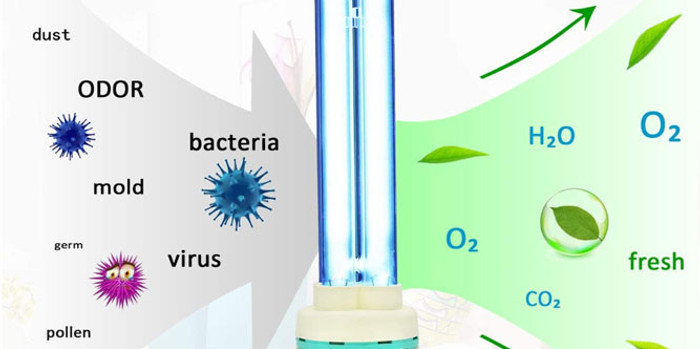The Basic Principles Of Uvc Light
The Basic Principles Of Uvc Light
Blog Article
Uvc Light Fundamentals Explained
Table of ContentsThe 45-Second Trick For Uvc LightUvc Light Can Be Fun For AnyoneGet This Report on Uvc LightNot known Facts About Uvc LightRumored Buzz on Uvc LightNot known Incorrect Statements About Uvc Light
A brand-new type of ultraviolet light that might be risk-free for individuals took less than five mins to minimize the level of indoor air-borne microbes by even more than 98%, a joint study by researchers at Columbia University Vagelos University of Physicians and Surgeons and in the U.K. has located. Also as germs continued to be splashed into the room, the level continued to be extremely reduced as long as the lights got on.But till now these researches had just been performed in little speculative chambers, not in full-sized rooms simulating real-world problems. In the current research study, researchers at the University of St. Andrews, University of Dundee, University of Leeds, and Columbia University evaluated the efficiency of far-UVC light in a large room-sized chamber with the exact same ventilation price as a typical office or home (regarding 3 air adjustments per hour).
The efficacy of different approaches to minimizing interior infection degrees is normally measured in terms of equivalent air modifications per hour. In this research study, far-UVC lights generated the matching of 184 comparable air exchanges per hour. This surpasses any other method to disinfecting occupied indoor spaces, where five to 20 equal air changes per hour is the best that can be achieved practically.
The 5-Minute Rule for Uvc Light

The major parameters of UV-C sanitation are wavelength, dosage, relative moisture, and temperature level. There is no agreement regarding their ideal values, however, as a whole, light at a high dose and a spectrum of wavelengths consisting of 260 nm is preferred in an atmosphere at space temperature with low relative humidity. This light can be produced by mercury-vapour, light-emitting diode (LED), pulsed-xenon, or excimer lamps.
UV-C sanitation systems have appealing functions and the possible to enhance in the future. UV-C disinfection should presently be considered for low-level instead than high-level disinfection.
An additional application arose in 1910 when UV light was utilized to sanitize water. Nowadays, UV light is made use of for water, air, food, surface area, and clinical tools disinfection.
Excitement About Uvc Light
DNA, RNA, or proteins of a micro-organism absorb UV light, with a peak absorbance around 260 nm [6] This results in the interruption of DNA or RNA, causing the inactivation of the micro-organism. see this UV-C-induced DNA disturbance typically contains the bonding of two adjoining thymine (or cytosine) bases rather of the traditional linking of a base with its complementary base upon the other strand.

Dark repair service, on the various other hand, calls for numerous enzymes and nutrients for power [6] It is very important to know whether last inactivation outcomes have thought about the incident of reactivation considering that it might result in 60% of the accomplished inactivation being reversed [7] Furthermore, mutations can emerge upon UV-C exposure given that this direct exposure can cause the origination of intra-strand cyclobutyl-pyrimidine dimers in DNA [ 6] The UV-C area is used for sanitation but there is no agreement on the exact optimal wavelength. Microbial DNA and RNA have peak absorbances of light at 260265 nm and around 260 nm, respectively [6] Light at 260 nm can cause the most interruption (uvc light). Various micro-organisms are most susceptible to a little various wavelengths.
The Best Strategy To Use For Uvc Light
It also has an added advantage by reducing photoreactivation through a decrease of photolyase [9] On the other hand, it has technical ramifications considering that the complete power of the light beam is then split over all existing wavelengths. As a result, a micro-organism that is prone to 254 nm light will certainly be suspended extra by a light that discharges only light find more information at 254 nm than a light that sends out a wavelength range at equal total power.
Direct exposure times of 1045 min for space disinfection and 25 s to 5 minutes for medical tools were come across in literature.
Further, the outcome of a light decreases over time, so it is suggested to compute the dose at the end of light life, which is rep of a worst-case situation. The dosage also influences the quantity of photoreactivation. Quek et al. discovered that the percent of photoreactivation decreased from 5.31% to have a peek here 0% for a boost in dose from 1.6 to 19.7 mJ/cm2 [8]
Zhang et al. observed a change in UV irradiance of 34% when the RH boosted from 50% to 90% [18] The quantity of RH influence on UV efficiency depends upon the present micro-organism and is more obvious for germs than for infections [16] The influence of temperature level depends on the light resource.
Rumored Buzz on Uvc Light


This is recognized as far UV-C innovation and is a relatively brand-new sanitation method with restricted understanding about its performance.
In research, the results on pulsed versus continuous UV-C sanitation performance vary. When comparing pulsed and constant light it is crucial to keep other variables such as wavelength and dosage consistent.
Everything about Uvc Light
In situation ozone is not required for disinfection, a modified lamp can be used. For mercury-vapour lights, doped quartz glass or specialized soft glass can remove short-wave UV-C light. For pulsed-xenon, drugged quartz can be used too [30] UV-C has promising functions for sanitation such as automatic disinfection, being less taxing than extensively used handbook or chemical sanitations, leaving no damaging residuals, and being eco-friendly (if no mercury-vapour lamps are utilized) [31,32]
Report this page